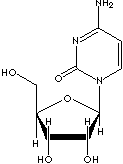Ribose
is a pentose (five-carbon sugar) that is a component
of the ribonucleic acid (RNA), where it alternates with
phosphate groups to form the 'back-bone' of the RNA
polymer and binds to nitrogenous bases. Ribose phosphates
are components of the nucleotide coenzymes and are utilized
by microorganisms in the synthesis of the amino acid
histidine. Its close relative, deoxyribose, is a constituent
of deoxyribonucleic acid (DNA), where it alternates
with phosphate groups to form the 'back-bone' of the
DNA polymer and binds to nitrogenous bases. The presence
of deoxyribose instead of ribose is one difference between
DNA and RNA. Ribose has one more oxygen atom in its
molecule than deoxyribose. Ribose has a five member
ring composed of four carbon atoms and one oxygen. Hydroxyl
groups are attached to three of the carbons. The other
carbon and a hydroxyl group are attached to one of the
carbon atoms adjacent to the oxygen. In deoxyribose,
the carbon furthest from the attached carbon is stripped
of the oxygen atom in what would be a hydroxyl group
in ribose. The sugar (ribose or deoxyribose) molecules
in the nucleic acid are all oriented in the same direction.
Their carbon atoms are numbered: the 5' carbon atom
is always on the side of the sugar molecule that faces
the leading end, while the 3' carbon atom always faces
the tail end. Nucleotide is the structural unit of a
nucleic acid. A nucleotide consists of either a nitrogenous
heterocyclic base (purine or pyrimidine) , a pentose
sugar (ribose or deoxyribose) and a phosphate group
attached at the 5' position on the sugar. A nucleoside
consists of only a pentose sugar linked to a purine
or pyrimidine base, without a phosphate group. Purine
bases are Adenine, Guanine and Hypoxanthine (examples
of purine nucleosides are Adenosine, 2'-Deoxyadenosine,
Guanosine, 2'-Deoxyguanosine, Inosine, 2'-Deoxyinosine).
Pyrimidine bases are Cytosine, Thymine, and Uracil (examples
of pyrimidine nucleosides are Cytidine, 2'-Deoxyguanosine,
5-Methyluridine, 2'-Deoxy-5-Methyluridine, Uridine,
2'-Deoxyuridine). The nucleoside derivatives are involved
in important functions in cellular metabolism and are
used to synthesize enzyme inhibitors, antiviral agents,
and anticancer agents.
Cytosine is a pyrimidine base, occurring condensed with ribose or deoxyribose to
form the nucleosides cytidine and deoxycytidine in animal cells. It is a
fundamental unit or base of nucleic acids. When N9 is linked to the C1 of
ribose, cytosine forms a pyrimidine nucleoside called cytidines which are
phosphorylated with from one to three phosphoric acid groups to form the three
nucleotides; cytidine monophosphate (CMP), cytidine diphosphate (CDP), and
cytidine triphosphate (CTP) respectively. When N1 is linked to the C1 of deoxyribose, deoxy nucleosides and nucleotides are formed from cytosine and
deoxyribose; deoxycytidine monophosphate (dCMP), deoxycytidine diphosphate
(dCDP), deoxycytidine triphosphate (dCTP). CTP is the source of the cytidine in
RNA (ribonucleic acid) and deoxycytidine triphosphate (dCTP) is the source of
the deoxycytidine in DNA (deoxyribonucleic acid). CTP is involved in the
formation of adenosine triphosphate (ATP) as a donator of phosphate groups to
adenosine diphosphate (ADP).
- Cytidine Monophosphate (CMP,
Cytidylic
Acid; ): a
nucleotide, the 5'-phosphate of cytidine, acting as a carrier of
N-acetylneuraminic acid in glycoprotein synthesis.
- Cytidine Diphosphate (CDP):
a nucleotide,
the 5'-pyrophosphate of cytidine, acting as a carrier of choline and
ethanolamine in the phospholipid synthesis.
- Cytidine Triphosphate (CTP):
a nucleotide, the 5'-triphosphate of
cytidine; precursor in the synthesis of ribonucleic acid and
of CDP- and CMP-linked compounds.
- Deoxycytidine
Monophosphate (dCMP): a nucleotide, the 5'-phosphate of deoxycytidine (deoxy-, also called desoxy, is a prefix for
the designation of compounds which contain one less atom of oxygen than the
reference substance).
- Deoxycytidine Diphosphate (dCDP):
a
nucleotide, the 5'-pyrophosphate of deoxycytidine.
- Deoxycytidine Triphosphate (dCTP):
a nucleotide, the
5'-triphosphate of deoxycytidine; an precursor in the synthesis
of DNA.
Chemically modified nucleotides substituted
or attached by special chemical groups or elements are studied
and used to inactivate the normal biological operation in the living organism
and the function of important enzymes.
|
